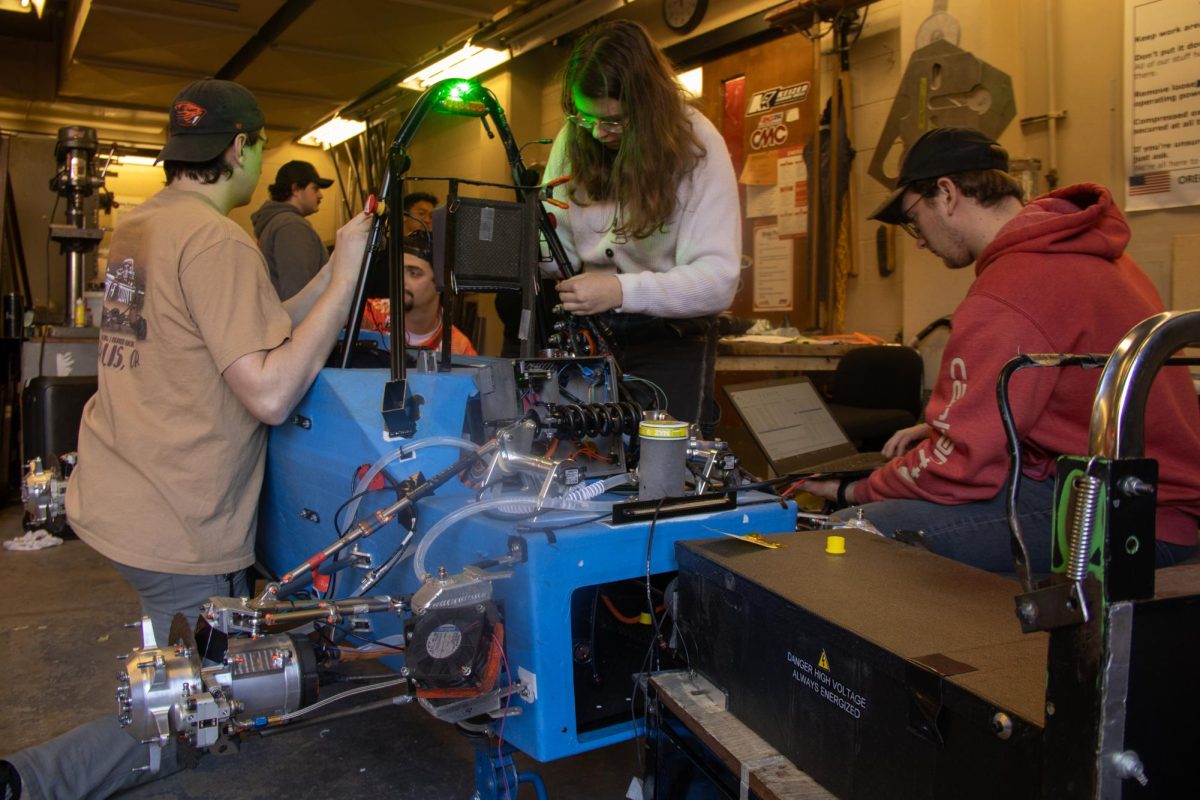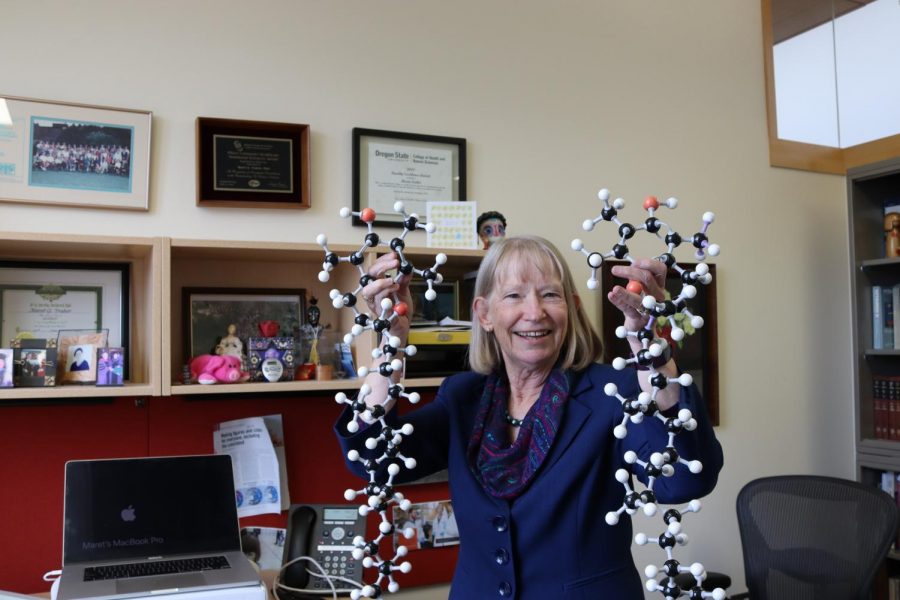OSU professor receives prestigious award for research on role of vitamin E in human body
Oregon State University Professor Maret Traber, in her office in the Linus Pauling Science Center on the Corvallis, Ore. campus, is excited about her recent Discovery Award for her research in bioavailable vitamin E on Nov. 18, 2021. Traber’s research has made massive strides in nutritional awareness for prenatal development involving vitamin E deficiencies.
January 3, 2022
Dr. Marie Traber, professor at the Linus Pauling Institute at Oregon State University, is the recipient of an award given to scientists who have made significant contributions to health-related research.
The 2021 Medical Research Foundation of Oregon’s Discovery Award was given to Traber for her research on the necessity of vitamin E to human health.
Traber was nominated for the award by Dr. Adrian Gombart, an OSU professor in the department of biochemistry and biophysics.
“Dr. Traber is literally the ‘Goddess of vitamin E,’” Gombart said. “She is one of the world’s leading experts in the field. In addition, she is an outstanding scientist with expertise in basic and clinical nutrition research. She has contributed immensely to moving the field forward and guiding public policy on the amounts of vitamin E needed for humans to remain healthy.”
Traber’s research started over 40 years ago when she was working at the New York University School of Medicine. She and her colleagues were interested in the inherited basis of metabolic diseases—anyone who had any kind of problem with lipids and liporoteins. Some of the patients at the NYU medical center with metabolic diseases were also some of the first people known to have a vitamin E deficiency.
“The only problem was, nobody knows how vitamin E gets from your dinner plate to your big toe,” Traber said.
She explained that vitamin E is a fat-soluble nutrient naturally found in foods such as leafy green vegetables and nuts and, when ingested, makes its way to various tissue in the body.
Intrigued by the unknown, Traber spent the rest of her career figuring out how vitamin E is transported throughout the body, its effects on biochemical cycles and the negative impacts of vitamin E deficiency.
Traber and her colleagues at NYU discovered that vitamin E is repackaged and transported through the liver. Once the vitamin is ingested, it makes its way from the intestines to the liver and is then dispersed to the various tissues throughout the body.
“[Vitamin E] is like a semi-truck filled with fat going from the small intestine to the liver,” Traber said. “The liver, then, is like the transfer place where it repackages the fat and puts it in smaller trucks that go out to deliver it to the tissues.”
So, finding out how vitamin E moves through the body is important, but why do humans need this essential vitamin?
“If you don’t have it, you die,” Traber said.
Discovered in 1922, vitamin E is required for proper neurological function in children and adults. Traber recently discovered its importance in fetal development. As a mother, if you are deficient in vitamin E, your child is more likely to have an underdeveloped brain and spinal cord.
“Ninety-six percent of women don’t consume adequate levels of vitamin E per day,” Traber said, emphasizing the importance of taking vitamin E supplements while pregnant.
You don’t need to be an expecting mother to experience the negative impacts of a vitamin E deficiency. Being deficient in vitamin E can lead to serious health concerns including nerve and muscle damage.
Athletes in particular are at a higher risk for experiencing negative effects of vitamin E deficiency due to their rapid intake of oxygen that generates a lot of free radicals in their body. In other words, when you’re active, you are more prone to oxidative stress, which can cause pain and strain on your muscles.
Vitamin E protects you from oxidative stress as it binds with the dangerous free radicals produced by your body.
“All of these pathways are interacting with each other,” Traber said.
According to Traber, OSU students can take the initiative to increase their intake of vitamin E and overall health.
“If you can get yourself in a situation where you can cook for yourself and you know what’s in your food, that would be my recommendation—probably save you some money too,” Traber said. “Kale, spinach, those are the kinds of foods that are rich in vitamin C, as are nuts and seeds.”
Traber said she is honored to receive the MRF Discovery Award and added that she hopes more young people will enter the field of science and make new discoveries that will make life better for everyone.
“Eat right, work hard and take over the world,” Traber said.
Dr. Emily Ho, endowed chair and director of the Linus Pauling Institute, praised Traber and the research she does at OSU.
“I cannot think of anyone more fitting [or] deserving than Dr. Traber to be honored,” Ho said. “She represents the best of the Linus Pauling Institute and the spirit of Linus Pauling—she is the Ava Pauling endowed chair—and she continues to be a strong role model for future generations of nutrition scientists, and anyone interested in nutrition and health.”



















































































![Newspaper clipping from February 25, 1970 in the Daily Barometer showing an article written by Bob Allen, past Barometer Editor. This article was written to spotlight both the student body’s lack of participation with student government at the time in conjunction with their class representatives response. [It’s important to note ASOSU was not structured identically to today’s standards, likely having a president on behalf of each class work together as one entity as opposed to one president representing all classes.]](https://dailybaro.orangemedianetwork.com/wp-content/uploads/2025/03/Screenshot-2025-03-12-1.00.42-PM-e1741811160853.png)























